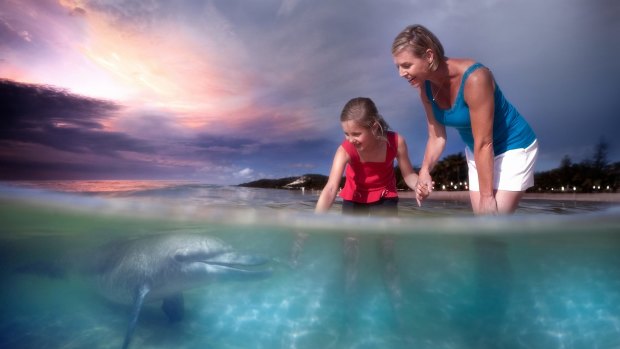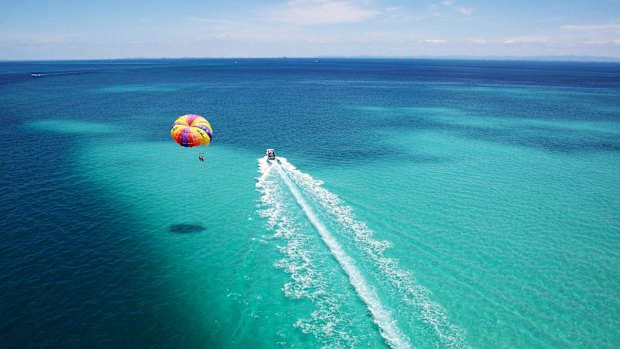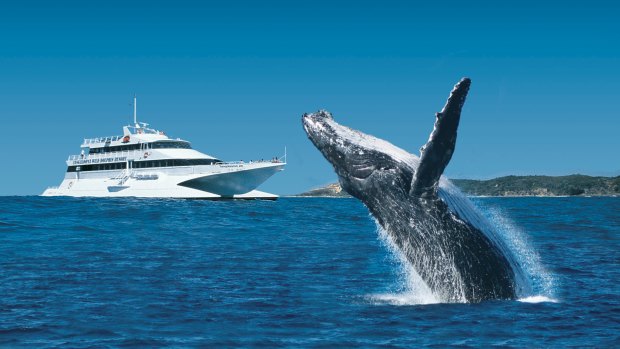This was published 7 years ago
Moreton Island, Queensland: Where you can hand feed dolphins in Australia
Mal Chenu visits an easy-to-reach resort where guests hand-feed dolphins and get up close to migrating humpback whales.
By Mal Chenu

Tangalooma - dolphin feeding?
When Nari was attacked by a shark in 2009 he lost a sizeable chunk of his head and wasn't expected to survive. But here he is – scars clearly visible – gently taking a fish from my hand in knee-deep water at Tangalooma Island Resort on Moreton Island, south-east Queensland.
Nari is one of 12 bottlenose dolphins that regularly turn up at the jetty here after dusk. And every guest gets to feed one and come away with a dolphin tale.
The dolphins are all members of two close-knit family groups. One family's lineage dates back to Eric, who started visiting the jetty at night in the 1980s. Resort owners Betty and Brian Osborne began feeding Eric and he took his first fish from Betty's hand in 1992.

Paragliding at Tangalooma Island Resort on Moreton Island.Credit: Mark Higgins
One day Eric turned up with a calf and was renamed Beauty. Beauty's daughter Tinkerbell is now a grandmother and still a regular visitor to Tangalooma. Not all of them come every night and tonight there are eight, which is about average.
Excited guests gather on the beach and Sue Hassard – manager of the Tangalooma Marine Education and Conservation Centre (TMECC) – provides a potted history and runs through the rules of the strictly monitored and Marine Park Authority-approved feeding program. This is a remarkable, life-affirming experience for the humans but the welfare of the dolphins comes first.
"We never feed the dolphins more than 20 per cent of their daily food intake and we only feed young dolphins after they have learned to hunt for themselves," Hassard says.
Wherever you stay you are likely to have an ocean view and be close enough to open your window and hear the gentle waves.
"The dolphins usually line up in the same positions every night. They know the handlers and seem very comfortable around people. They trust us and mothers bring their newborn calves into the feeding area and encourage them to take fish."
These dolphins are like family to the Tangalooma tribe. They have fed, rescued, reared, celebrated and mourned them over the years and a great deal of time, money and love have gone into their care.
The Osbornes set up the TMECC in 1994 and this browse-worthy resource and its daily walks, talks and tours and are now a must-do for many Queensland schoolkids as well as resort guests. (See tangaloomaecomarines.com.au for details of this admirable environmental program.) One intriguing display in the centre shows off the "gifts" (mostly half-eaten eels and fish, admittedly) presented by the dolphins over the years. The reason for this behaviour is uncertain but Hassard believes it may be a form of gratitude.

Whale watching is a major drawcard at Moreton Island.
The Moreton Bay Marine Park is home to 700 dolphins, 600 dugongs, 2000 loggerhead turtles and 10,000 green sea turtles. Pelicans – just one of the 195 bird species on Moreton Island – also seem very much at home here. During the day about 20 take up residence in a dedicated space next to the jetty, while pied cormorants, curlews and kookaburras also delight the guests.
Whale watching is another major draw here. Between early June and mid-October, humpbacks migrate up and back from Antarctica in great numbers. Tangalooma was originally a whaling station and more than 6000 were taken from 1952 to 1962, reducing numbers to around 500 from an original 15,000. The population has boomed to a healthy 22,000.
Our whale-watching cruise heads up the west coast of the island in perfect, glassy conditions and Queensland winter sunshine. We pass the state's oldest lighthouse at the northern point of the island and soon spot the unmistakable misty spouts. Captain Tracey carefully manoeuvres the ship to maximise the experience without frightening the whales and cameras record the action for the next two hours. Every cruise includes an "eco-ranger" and today it is marine biologist Tessa, who spots the pods and describes their behaviour.
Everyone is hoping to see Migaloo. The legendary albino whale has been spotted heading up the coast and will pass through this area at least twice this season.
Migaloo's movements are reported on the evening news every night and his celebrity is such that he requires a police escort to protect him from over-eager boats and even low-flying drones. We don't see Migaloo but we do see 15 humpbacks at reasonably close range – including a mother and calf – as well as a pod of dolphins.
Moreton Island is the third-largest sand island in the world (after nearby Fraser and North Stradbroke), just off the coast from Brisbane. It is about 38 kilometres long and 10 kilometres wide at its widest point, a 17,000-hectare national park except for the 2 per cent of the island that comprises Tangalooma and three tiny residential townships.
When the Osborne family bought Tangalooma in 1980 they had a staff of 27, which has grown to around 325 today. The resort offers seven types of accommodation and the apartments at Deep Blue are the pick of the bunch. These suites sleep between six and 10 (counting foldouts) and have two bathrooms, a spa bath, full kitchen, living/dining room, laundry, two TVs and a balcony with barbecue.
Wherever you stay you are likely to have an ocean view and be close enough to open your window and hear the gentle waves. Resort shops include a day spa, general store and photo shop where you can buy holiday snaps taken by the resort's busy paparazzi.
The resort faces west and sunsets over the water are a highlight, ideally paired with a glass of something appropriate. A fine-dining future and more wine pairing are also on the horizon, with a new bar and restaurant under construction and the recent appointment of new chef, Hamish Neale.
Neale is aiming for a nautical feel and interesting treatments of local bugs, oysters and other seafood. "We're not going to change the world but we are going to make this a food destination to match the natural attractions," he says.
Current dining options include the excellent Beach BBQ, presenting fresh seafood and steak cooked to order, the Szechuan-themed Fire and Stone, and burgers, pizza, salads and light meals at Beach Cafe.
FIVE MORE THINGS TO DO AT TANGALOOMA
Desert safari tour and sand tobogganing
Fifteen minutes from the resort is a 20-hectare "desert", a denuded expanse of sand of uncertain origin. The 4WD outing is accompanied by "Aussie" Paul's fascinating and hilarious commentary: "Yeah, we have termites as big as cats in Australia," he tells the mostly Asian guests. The highlight is the sand tobogganing, which can reach speeds of 50km/h with the right technique. The wrong technique results in highly entertaining face-plants. Adults $43, children $25.
Quad biking
Carve tracks in the firm, pristine beach sand on the four-wheel, all-terrain-vehicles. There are various tracks but the favourite is the run down the beach to Tangalooma Point and back. You're getting the hang of it when you start to drift your rear wheels. Adults $60.
Snorkel the wrecks
Check out the coral formations and fish on the shallow, sunken hulks near the shore. Guided 1.5-hour tour $55. DIY snorkelling equipment hire $49 a day. Scuba also available.
Parasailing
Enjoy the view along the shore of the island and keep an eye out for dugongs, turtles and dolphins. Six to eight-minute solo standard flight: $95 a person.
Not to mention
Fishing, paddleboards, boat hire, kayaking, banana boat rides, Segway rides and cycling on the beach, tennis, squash, playground, archery, boules, minigolf, beach volleyball, bush tucker eco-walks, sunset cruises and more.
TRIP NOTES
MORE INFORMATION:
GETTING THERE:
Virgin Australia flies to Brisbane daily from Sydney and Melbourne. virginaustralia.com
The Pinkenba wharf is just 15 minutes from the airport and ferry transfers take 75 minutes to reach the island. Adults $80 return; children $45.
STAYING THERE:
Tangalooma Island Resort offers six types of accommodation (3.5-4.5 star) within the resort. Rates and minimum stays vary depending on the rooms, days of the week and seasons. As an example: Hotel Standard room (up to four guests) $199 a night weekdays in the low season; three-bedroom Deep Blue Apartment (up to seven guests) $755 a night weekends in the high season. And lots of options in between. Off-resort holiday houses (8-12 guests) also available from $335 a night (four-night minimum). Dolphin feeding (one night) is included in your accommodation. Whale Watch Cruises including a light lunch $115 an adult, $75 child.
Mal Chenu was a guest of Tangalooma Island Resort.
Sign up for the Traveller Deals newsletter
Get exclusive travel deals delivered straight to your inbox. Sign up now.